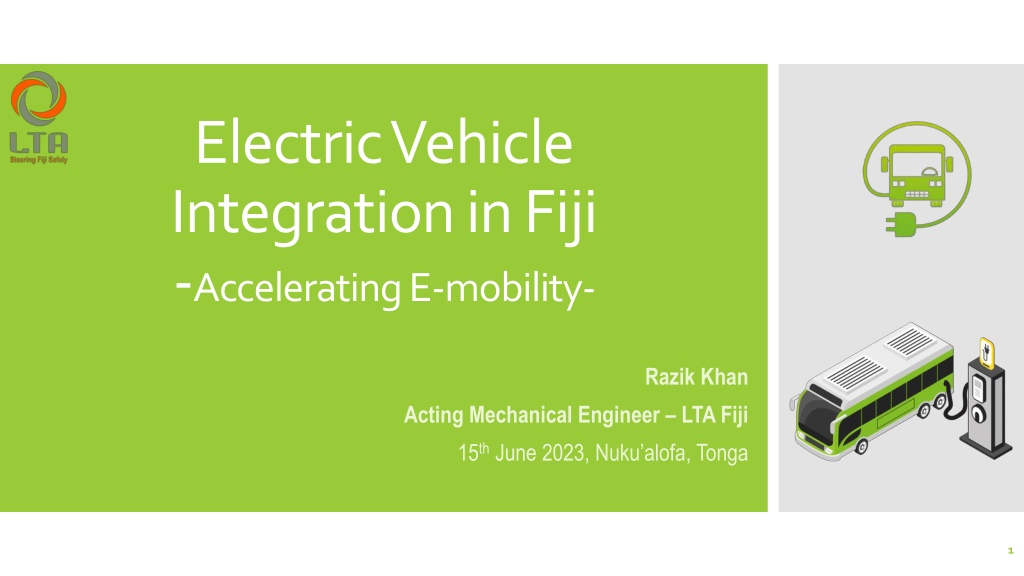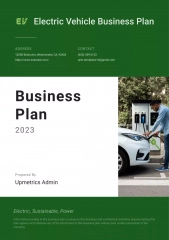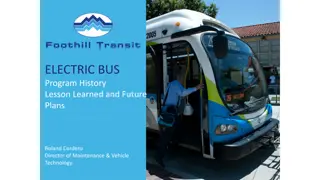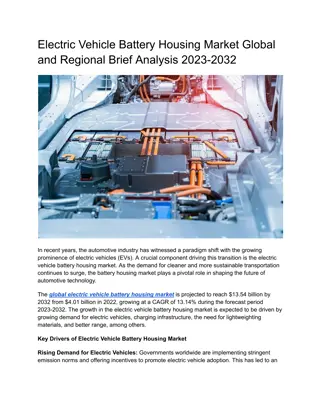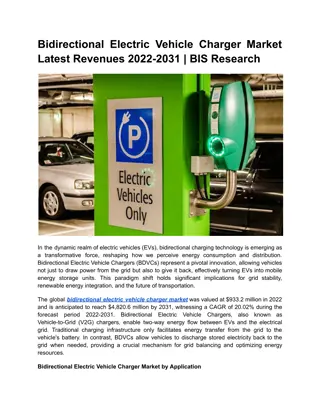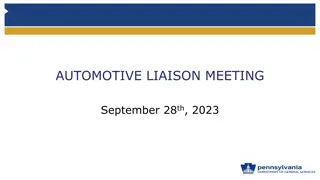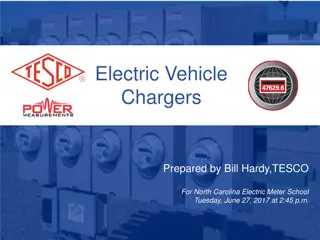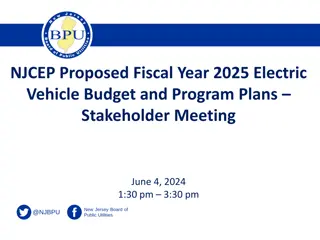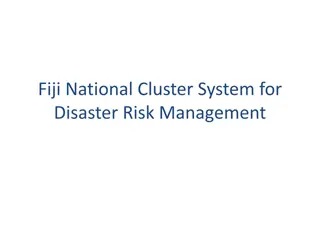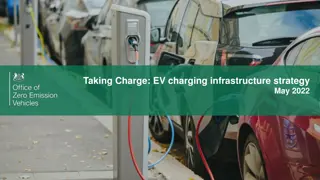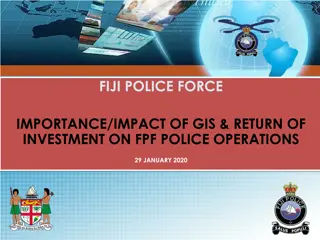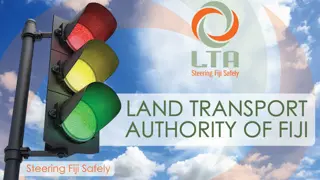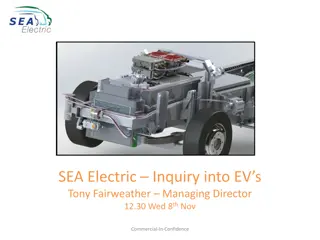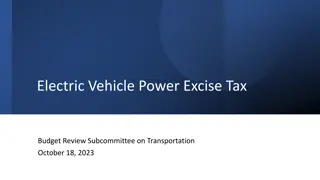Accelerating Electric Vehicle Integration in Fiji
Developing Fiji's electric vehicle infrastructure requires addressing key technical requirements such as charging infrastructure, battery recycling, vehicle standards, and government incentives. Establishing regulations around vehicle importation and charging infrastructure is crucial for a successful transition to EVs in Fiji.
Download Presentation

Please find below an Image/Link to download the presentation.
The content on the website is provided AS IS for your information and personal use only. It may not be sold, licensed, or shared on other websites without obtaining consent from the author. Download presentation by click this link. If you encounter any issues during the download, it is possible that the publisher has removed the file from their server.
E N D
Presentation Transcript
Electric Vehicle Integration in Fiji -Accelerating E-mobility- Razik Khan Acting Mechanical Engineer LTA Fiji 15thJune 2023, Nuku alofa, Tonga 1
2 main Islands Population Fiji ~900,000 69% below 40 years ~300 Islands Overview 2
Smaller bus routes greater efficiency in EV operations High % of younger population Higher potential for change. International benchmarking lessons learnt Opportunities Government Incentives Available 3
Charging Infrastructure One of the key technical requirements for accelerating EV deployment in Fiji is the availability of charging infrastructure. We will need to invest in the installation of charging stations across the country to support the growing number of EVs on the roads. This will require significant investment in both hardware and software. Battery Recycling Another important technical requirement for EV deployment is the development of a battery recycling program. Batteries used in EVs contain valuable materials that can be reused, but they also contain toxic chemicals that need to be properly disposed of. Developing a battery recycling program will ensure that the materials are reused, and the toxic chemicals are safely disposed of. Technical Requirements 4
Vehicle Standards Fiji will need to establish vehicle standards for EVs to ensure that they meet safety and environmental requirements. This includes establishing regulations around the types of batteries used in EVs, the range of the vehicle, and the charging and discharging rates. Technical Requirements Government Incentives The government can provide incentives to encourage consumers to purchase EVs. For example, the government can provide tax credits or rebates to people who purchase EVs, or it can offer subsidies to companies that invest in charging infrastructure. 5
Vehicle Importation Regulations Fiji will need to establish regulations around the importation of EVs to ensure that they meet safety and environmental requirements. Additionally, a long term plan on the phasing out of ICE vehicles import needs to be developed and adopted. A long term plan will ensure a smoother transition. Charging Infrastructure Regulations Fiji will need to establish regulations around the installation and operation of charging infrastructure to ensure that it is safe and reliable. Regulatory Framework Battery Recycling Regulations Fiji will need to establish regulations around the recycling of batteries to ensure that there is proper disposal of toxic chemicals and that the materials are reused. 6
End of Life system for ICE Vehicles To integrate EVs the first step would be to create a sustainable End of Life system for existing ICE vehicles. This will smoothen the shift towards e-mobility Incentive Programs The Government incentive programs need to be properly designed to ensure that they are effective and sustainable. Careful consideration will have to be given to the design of these programs to ensure that they are targeted to the right groups and that they align with the overall goals of reducing greenhouse gas emissions and transitioning to a more sustainable transportation system. Policies and Awareness Public Awareness Campaigns Public awareness campaigns will be required to educate the public about EVs and their benefits. These can help to dispel myths about EVs and promote their advantages, such as lower operating costs, reduced emissions, and a quieter and smoother ride. 7
Multi-sector approach required Energy, Transport, Customs, Standards, etc. Alignment to Fijis climate commitments. Energy sector alignment is high priority. Multi-Sector Collaboration Clearly set requirements and regulatory framework to catalyze EV integration 8
EV Deployment Enablers 9
In the short to medium term, some of the key areas that can be looked at are; A compliance base end of life system for vehicles. Electrification of Busses Next Steps 10
Instead of having an age based vehicle end-of-life structure a compliance based end-of-life system looks more rewarding. This will ensure that vehicles in use are efficient and will also promote a shift towards cleaner, greener and more efficient vehicles. Vehicle tailpipe emissions can be used as a pass/fail criteria during renewals, i.e. vehicles failing emission tests will be not be renewed. End-of-Life This will lead to two things; 1. Replacement of non-compliant vehicles. 2. Guarantee better service and maintenance of all registered vehicles to comply to the required standards. 12
Emission tiers can be developed as; Tier 1 most stringent emission standards. All vehicles falling in the tier can be exempt from paying an emission levy. Tier 2 slightly less stringent. Vehicles in this tier will be registered but will be required to pay a calculated emission levy based on vehicle usage to continue having the vehicle registered. Emission Levy Tier 3 least stringent. Vehicles in this tier will be registered but will be required to pay a higher calculated emission levy based on vehicle usage to continue having the vehicle registered. 13
Cost for full Capacity Cost for full Capacity 250 kwh x $0.3401 120L x $2.61 $85.02 $376.80 (For 132km range) (For 306km range) E-Buses vs ICE Buses ($) Energy cost per km Fuel cost per km $85.02 132 ?? $0.64 per km $313.20 306 ?? $1.02 per km 15
EV Type Battery Capacity 60 kwh 118 kwh 320 km 240 km Range Passengers 5 24 E-Bus vs Private EVs 0.19 kw/km 0.49 kw/km Energy Consumption Energy Consumption Per passenger 0.04 kw/km/person 0.02 kw/km/person Reference Model; Nissan leaf Reference Model; Greenstar EV *These calculations are based on best case scenario - most private cars run with only 1 or 2 occupants. 16
Pre-shipment vehicle inspections Inclusion of emission tests, hybrid vehicle battery testing, verification of emission standards Open Taxi Ranking System Increasing efficiency of taxi operations and reducing frequency of empty runs Technical Assistance and Data Provision Development of Fiji s LEDS Development of Fiji s NDC Development of Fiji s NEP Procurement of Emission Testers for Diesel/Petrol and LPG vehicle tailpipe emissions through grant funding MOU with Universities for training development and R&D on EV projects. Private Sector 3 wheeler verification and approval for 10 units. Projects Implemented 17
A Pilot Project to aiming prove Electrical shuttle technologies LTA Technical Support Route Selection and Mapping Route Data Collection Route Energy Analysis Technical Assistance in fleet planning Development of draft operating model and rules Bus Shuttle Project 18
Available Incentives 19
